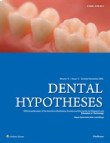فهرست مطالب

Dental Hypotheses
Volume:14 Issue: 4, Oct -Dec 2023
- تاریخ انتشار: 1402/09/22
- تعداد عناوین: 6
-
Pages 95-99Introduction
Dental pulp regeneration is fundamental in dentistry and endodontics; however, few in vitro experimental models are available to study its biological process. This study aimed to develop a three-dimensional (3D) culture model of human dental pulp-like tissue mimicking the possible complexity of human pulp tissue. This new and innovative human-like tissue model could be used for testing drugs and materials, particularly those involved in regenerative endodontics.
MethodsVital pulp tissue samples were obtained from human third molars (n=4) immediately after extraction and cultured in a 3D fibrin matrix to create a sustainable ex vivo experimental model. The angiogenesis degrees and the nitric oxide levels were evaluated following the culture of pulp-like tissues in the fibrin matrix for 21 days. The expression of Transforming growth factor- beta (TGF-b1), TGF-b2, TGF-b3, and their relevant receptors, tumor necrosis factor (TNF) and vascular endothelial growth factor A (VEGFA) was evaluated using a reverse transcription polymerase chain reaction (RT-PCR) method.
ResultsPulp tissue angiogenesis was initiated, and completed on days 7 and 21, and pulp-like tissue cells expressed TGF-b1, TGF-b2, TGF-b3, and their relevant receptors, TNF and VEGFA.
ConclusionThis model provided a precise observation of dental pulp angiogenesis at early stages.
Keywords: Regenerative endodontics, dental pulp tissue, three-dimensional culture -
Pages 100-102Introduction
The aim of this study was to determine the salivary levels of interleukin-8 (IL-8) and interleukin-34 (IL-34) among patients with periodontitis and healthy individuals.
MethodsThirty participants with periodontitis and 30 healthy individuals were enrolled in this study. Enzyme-linked immunosorbent assay (ELISA) was used to determine salivary levels of IL-8 and IL-34, blindly. Statistical analysis was carried out by unequal variances t-test (Welch’s t-test) and the Pearson correlation coefficient using R software.
ResultStatistically significant differences were found between participants with periodontitis and healthy subjects regarding salivary levels of IL-8 (P=0.012) and IL-34 (P < 0.001). There was a non-significant (P > 0.05) correlation between salivary levels of IL-8 and IL-34 and periodontal parameters, including plaque index, bleeding on probing, probing pocket depth, and clinical attachment loss.
ConclusionWithin the limitations of this study, the salivary levels of IL-8 and IL-34 were higher among participants with periodontitis in comparison with healthy subjects. In the periodontitis group, salivary levels of IL-8 and IL-34 were not correlated with clinical indicators of periodontitis.
Keywords: ELISA, interleukin-8, interleukin-34, periodontitis, periodontal disease, salivary biomarkers, saliva -
Pages 103-106Introduction
We aimed to assess the impact of adhesive and wires types on the tensile bond strength of fixed lingual retainers.
MethodsA total of 160 intact bovine teeth were collected, cleaned, stored in 25% sodium hypochlorite, and randomly assigned to two groups based on the adhesive type: a two-step adhesive and a one-step adhesive. Each group was further divided into four subgroups based on the type of lingual retainer wire, which included (A) 8-strand braided stainless steel wire, (B) three-strand titanium retainer wire, (C) stainless steel chain, and (D) fiber-reinforced retainer. A tensile bond strength test was conducted using a universal testing machine at a controlled speed of 10 mm/min.
ResultThe 8-strand braided stainless steel wire and stainless steel chain bonded by one-step self-priming adhesive showed significantly higher tensile bond strength (P < 0.001). The adhesive wire significantly affected the tensile bond strength (P < 0.001).
ConclusionWithin the limitations of this in vitro study, it can be concluded that stainless steel wire and chain bonded by one-step self-priming adhesive showed higher tensile bond strength.
Keywords: Dental bonding, lingual retainer orthodontics, orthodontic retainers, orthodontic wires, tensile bond strength -
Pages 107-110Introduction
We aimed to assess the penetration depth of bioceramic sealers into the dentin tubules following different root canal obturation techniques included (A) warm vertical compaction, (B) carrier-based technique, (C) cold lateral compaction, and (D) single-cone obturation.
MethodsThis study utilized 40 extracted lower first premolars with developed apices and circular and straight root canals. The roots were eliminated to achieve an 11-mm length with a coronal flat measurement point. ProTaper Next rotary system was used for instrumentation. For obturation procedures, gutta-percha and Bio-C bioceramic sealer were employed, and the roots were randomly divided into four study groups, including (A) warm vertical compaction, (B) carrier-based technique, (C) cold lateral compaction, and (D) single-cone obturation. Depth of sealer penetration into the tubules was assessed using scanning electron microscopy.
ResultWe found significant differences in the penetration depth of bioceramic sealers based on obturation techniques (p < 0.001), location of dentin tubules (coronal, middle, or apical third) (p < 0.001), and the interaction between obturation techniques and location (p=0.042).
ConclusionThe warm vertical compaction and carrier-based technique showed superior penetration depth into the dentin tubules.
Keywords: Endodontics, Root canal obturation, Root canal sealants, Dentin, Scanning transmission electron microscopy -
Pages 111-113Introduction
The lateral canal that occurs in the mesial root of the mandibular first molar is relatively rare. Herein we reported a rare case about a large lateral canal located in the middle of the mesial root of mandibular molar.
Case report:
A 38-year-old woman presented with symptomatic apical periodontitis and J-shaped bone defect similar to vertical root fracture on the mesial root of tooth #30. Endodontic microsurgery was chosen to make a clear diagnosis and treatment. The procedure was carried out with apicoectomy, root-end and lateral canal preparation, and retrograde filling. At the 1-year follow-up, clinical examination and the radiograph showed complete healing.
DiscussionThe untreated mesiobuccal root canal with large lateral canal was found to be the cause of the J-shaped bone defect.
Keywords: Endodontic microsurgery, symptomatic apical periodontitis, lateral canal, mandibular molar

